A case study published in the December 2019 issue of the journal IPCM
In the multifaceted and complex field of surface treatments, ‘added value’ can have different meanings: a unique and high-quality aesthetic finish, attentive and complete service, or competitive delivery times. Very often, added value is actually the combination of all these factors. However, corrosion protection is taking on an increasingly crucial role, along with the ability of companies to guarantee longer service life of products even in sectors where anti-corrosion treatments are not normally required. The importance of corrosion protection is certainly not something new: anyone working in this eld knows how crucial it is, both since it ensures the durability of assets and because all other factors, especially aesthetics, depend on its effectiveness.
In the heavy-duty industry, including the naval, o shore, energy, and infrastructure sectors, all with particularly harsh environments, corrosion protection is perhaps the added value par excellence. Isoplus Mediterranean (Villamarzana, Rovigo, Italy) has made the protection of its pipeline for the oil & gas sector a distinguishing feature and an added value offered to its customers and users all
over the world (ref. Opening photo). “Isoplus Mediterranean was established in 2009 and it belongs to the Isoplus Group, which has twenty offices worldwide and whose core business are bar-based and flexible pre-insulated pipelines,” explains Fabio Zen, the plant director of Isoplus Mediterranean. “Isoplus Mediterranean stands out from the rest of the Group due to the choice it made in 2013 to add corrosion protection services to its district heating business. This was based on the knowledge and experience of our current management, which have enabled us to develop an actual separate division, ultimately making Isoplus Mediterranean the only company in the Group to offer this service,” says Zen.
The firm installed its first plant to protect oil & gas pipelines in 2014; since then, it has revamped it a few times. In order to guarantee better anti-corrosion paint adhesion and mechanical protection for its pipes, Isoplus has recently installed a shot blasting system provided by OMSG-Officine Meccaniche San Giorgio SpA (Villa Cortese, Milan, Italy), a company specialising in the design and construction of shot blasting, sand blasting, and shot peening systems.
The production flow
“Isoplus Mediterranean specialised in corrosion protection treatments. We are able to coat pipes for downstream, middle stream, and upstream processes in the oil & gas sector, treating tubes up to 24 metres in length and with diameters up to 26 inches,” states Fabio Zen. “Our production ow is totally automated. It starts with the reception of the material and the first cleaning phase, if we find any grease residues on it (Fig. 1).

If the pipe is clean, it goes directly to the heating station: the tube must have a temperature exceeding the air dew point, in order to obtain an optimal coating. This enables us to perform an optimal shot blasting operation by preventing the pipe’s humidity from acting as an adhesive for the media, thus creating a substrate that would undermine the quality and resistance of the coating.”
“After heating, we shot blast the external surfaces of the pipes in two plants: the first one removes any rust layer with a blast cleaning process, whereas the second one creates the right roughness profile to favour optimal coating adhesion,” says Zen.
“We installed the latter in July 2018: it is an OMSG SANDERPIPES 80 2-7 plant (Fig. 2) equipped with two centrifugal turbines with an installed power of 75 Kw each, arranged longitudinally in the lower part of the machine. This means that the distance between the turbines and the surface to be treated is constant, allowing us treating any diameter and ensuring that the ow of media always hits the workpiece (Fig. 3).”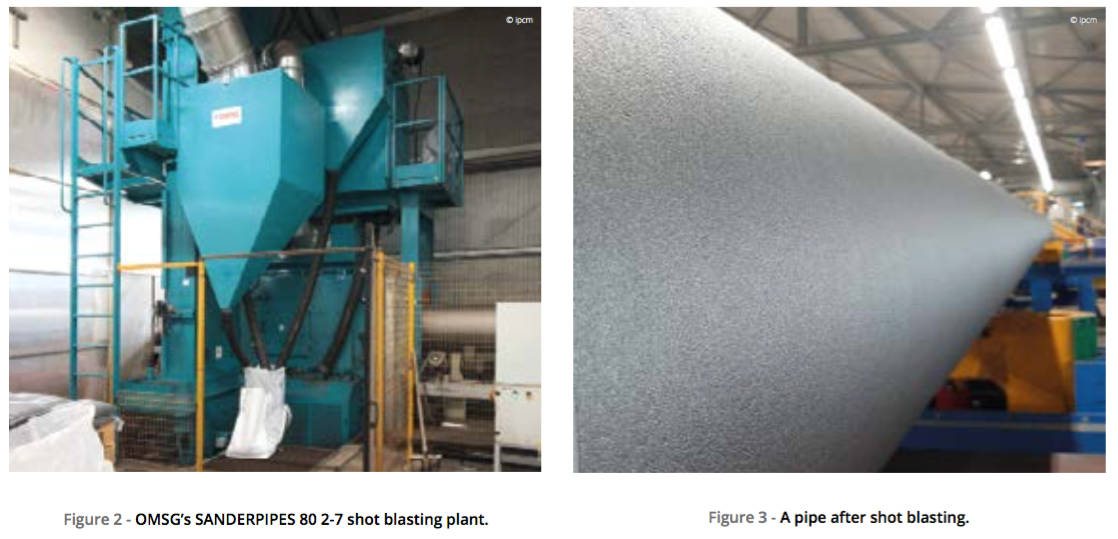
The shot blasting tunnel passages are shielded to minimise media spillage through a series of special, easily removable curtains and with a sealing element that can be quickly replaced when the part diameter changes (Fig. 4). After hitting the surface to be treated, the metal grit it is collected by a screw conveyor placed on the bottom of the booth to be recovered.
Then, the tube is reheated to a temperature of 230 °C (Fig. 5) to be coated. “With conventional plants, paint is applied and then the component enters the oven for the curing phase. In our work ow, the same amount of energy normally provided by an oven is transmitted by the tube itself: as it is heated before the paint application, is able to change the state of the applied material, thus favouring the cross- linking of the coating,” explains Fabio Zen. “Combined with the shot blasting operation, this process ensures optimal paint adhesion and enables us to apply thicknesses up to 800 microns, according to customer specifications (Fig. 6).”
The company uses thermosetting powder coatings supplied by AkzoNobel, Axalta, Jotun, and 3M. “The line is U-shaped and about 250 meters long. A cycle lasts about an hour,” says Alessandro Travaglini from the HSE department of Isoplus Mediterranean. “The coating application is followed by a cooling phase (Fig. 7), quality control, marking, and the final preparation of the workpieces for storage or shipment.”

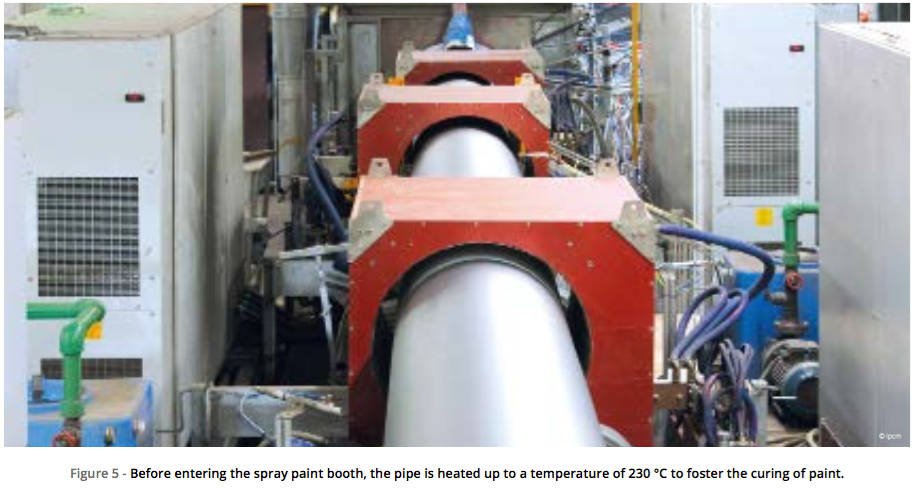
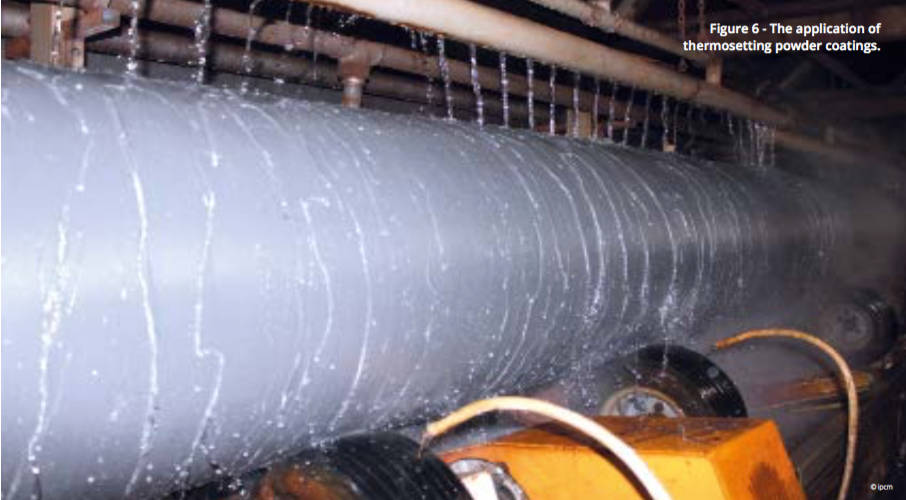
Conclusions
“When we installed our production line dedicated to oil & gas pipes, it was equipped with just one shot blasting system both for the cleaning and rust removal operations and for the surface roughening one for better paint adhesion,” states Fabio Zen. “Our need for higher productivity led us to install a second in-line shot blasting machine, thus separating the cleaning phase from the surface preparation one. Moreover, since we treat pipes with different sizes, we needed a system guaranteeing not only maximum exibility but also optimal performance regardless of the tubes’ diameter.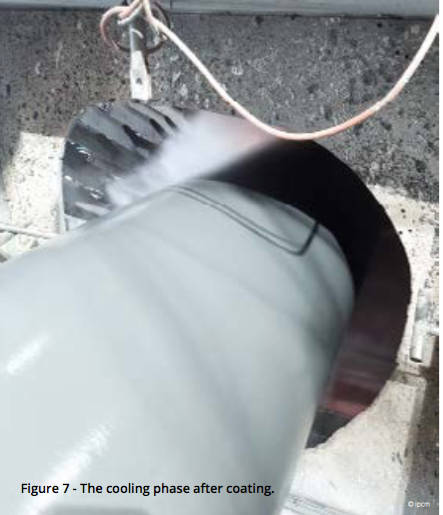 We already knew OMSG and, in particular, Ennio Tombetti, its general manager, with whom we have had a relationship of collaboration and trust for several years now. Also thanks to the experience gained in the pipe sector by CARLO BANFI, a long-standing competitor of OMSG that was recently acquired by the Villa Cortese-based Group, they immediately understood our needs. The project they presented to us was the most suitable solution: this is why we chose a SANDERPIPES machine.”
We already knew OMSG and, in particular, Ennio Tombetti, its general manager, with whom we have had a relationship of collaboration and trust for several years now. Also thanks to the experience gained in the pipe sector by CARLO BANFI, a long-standing competitor of OMSG that was recently acquired by the Villa Cortese-based Group, they immediately understood our needs. The project they presented to us was the most suitable solution: this is why we chose a SANDERPIPES machine.”
“The shot blasting system was installed in July 2018. After more than one year, we are very pleased with it: it does not only favour optimal coating adhesion, but it also guarantees perfect mechanical protection,” states Zen. “Finally, the relationship of trust established with OMSG, as well as the quality of their products, led us to choose another shot blasting plant supplied by them to replace the one currently used for blast cleaning our pipes. It will be installed in the early months of 2020.”








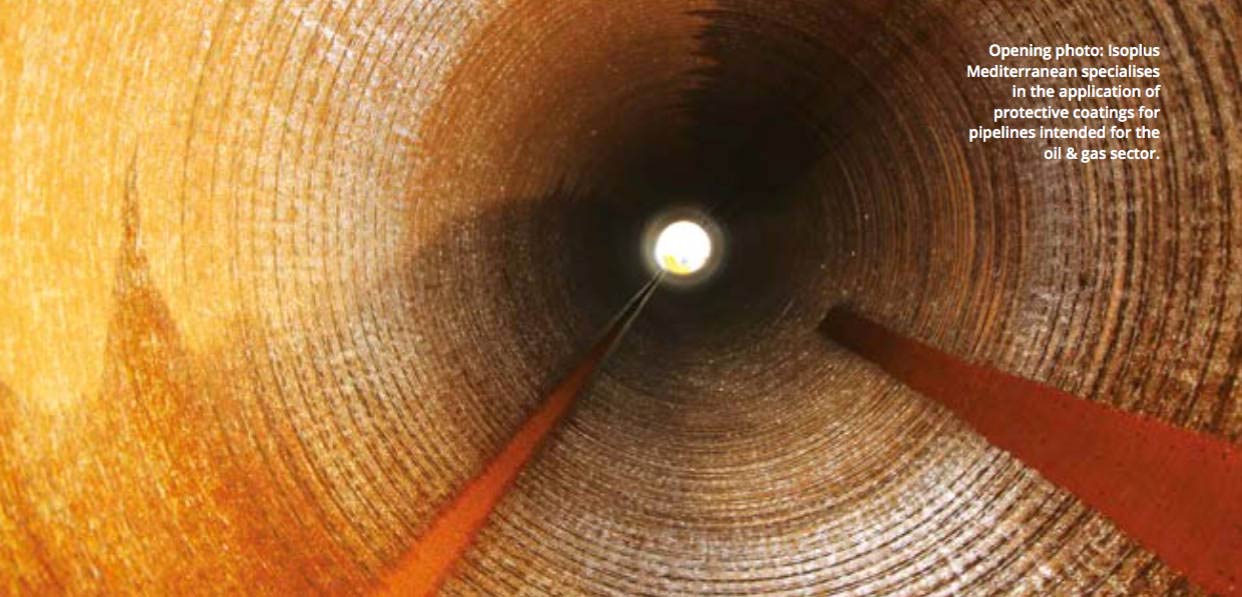
 English
English